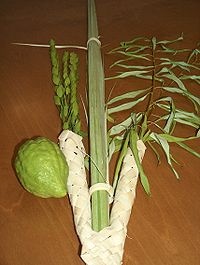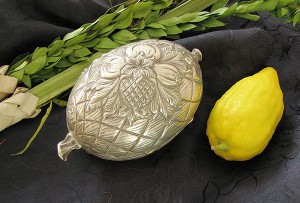ALL ABOUT THE FOUR SPECIES

The Arbah Minim (‘Four Species’) are 4 plant species which are used ritually as part of the observance of the festival of Sukkot. Three of the species (the palm, willow and myrtle) are placed in a special plaited holder and collectively are known as a ‘lulav’; the 4th of the four species, the fruit of the citron tree which is known in Hebrew as an etrog, is held together with the lulav.
- It is ordained in Leviticus 23:40: “On the first day (of Sukkot) you shall take the product of hadar (goodly) trees, branches of palm trees, boughs of leafy trees, and willows of the brook, and you shall rejoice before the Lord your God seven days.”
- The three of the four species which are bound together – the palm, the willow and the myrtle – are collectively called the lulav (‘palm’) as it is the largest of the species.
- The “fruit of goodly trees” has been interpreted to mean the etrog (citron*). “Branches of palm trees” are the lulav; “boughs of leafy trees” refers to the myrtle; and “willows of the brook” are the aravot or hoshanot.
- The four species allude to the four-letter name of God. The four are held together to signify the Unity of God.
- Each species has a particular reference to God, according to a Midrash in Leviticus Rabbah, 83: the etrog is symbolic of Psalm 104:1: “You are clothed in glory and majesty”; the palm is used because it is said Psalms 92:13: “The righteous bloom like date-palm”; the myrtle signifies Zechariah 1:8: “And he stood among the myrtle-trees”; the willow is significant because it is written in Psalms 68:5: “Extol Him who rides on the clouds (aravot), the Lord is His name.”
- The lulav implies the symbolism behind taste and smell. While the etrog has taste and smell, the lulav has taste but no smell. The myrtle has smell but no taste, and the willow has neither. Therefore the lulav is a depiction of every type of man: each being different, as a community they stand together.
- Each of the four species signifies a limb of the body: the etrog refers to the heart; the lulav the upright backbone; the myrtle symbolizes the eyes, and the willow the lips. Each of the limbs is a means through which man serves God.
- There is also a masculine-feminine theme inherent in the four species. The lulav represents masculinity, whilst the etrog is seen as feminine, in its form. As symbols of divinity, they must be perfect in every way; therefore, the branches are chosen with care.
- The cluster stays together with a special holder made from the leaves of a lulav. The two willow branches are placed to the left of the lulav, the three myrtle branches to the right. The etrog remains separate.
- The four species celebrate the diversity of man and the many different forms of God’s presence.

Laws & Customs for Waving the Four Species
It is a mitzvah (commandment) to shake or wave the Four Species on each of the seven days of Sukkot, usually before or during the Morning Service (Shacharit). This shaking or waving is symbolic of the completion of the yearly dycle, or freedom, and of peace and harmony. We shake the lulav in every direction to indicate God’s presence throughout the world, while facing towards Jerusalem.
- Before the blessing for the lulav is recited, a meditation is read. Then the etrog (citron) is held in the left hand, with its stem pointing downwards. After the blessing it is reversed, to face upwards.
- The lulav cluster, held in the right hand, is then shaken.
- When shaking the lulav, one should be facing east. The lulav is held out in front to the east and shaken three times. Each time the lulav is shaken it should be performed with a motion that first reaches outwards and then draws in.
- The same motion is repeated altogether five times: to the right (south), behind and over the right shoulder (west), to the left, up and down. Each must be done with intent, slowly and deliberately.
- The lulav is also waved during the recital of Hallel, a hymn of praise.
- The motions involved in the waving of the lulav are highly symbolic. On a simple level they display joy and gratification for God’s provision of the final harvest.
- The waving of the lulav also represents the fertility of the land and the desire for rain to ensure the next harvest. It is also indicative of God’s rule over nature.
- The motioning of the lulav symbolises our immersion in the festival of Sukkot, which completely surrounds one. The waving of the Four Species emphasizes God’s presence, which is drawn in, therefore drawing one closer to God.
- The lulav is not shaken on Shabbat.
- It is important that everyone has his or her own lulav. A lulav cannot be borrowed, but can be given as a gift. All of the Four Species must be fresh and in perfect condition.
How to buy and care for the Four Species

Protective cases for etrogs are available in a variety of designs and materials.
The principle behind buying the Four Species is called hiddur mitzvah, which translates as commandment of beauty, ensuring absolute perfection in each one.
- The lulav and etrog can usually be bought from a Jewish bookstore or Judaica shop. These may need to be pre-ordered.
- An alternative is to buy a set from a local synagogue. In Sydney, the Bnei Akiva youth movement also sells sets.
-
The etrog is the hardest of the four species to procure. It is implied that the etrog must be beautiful, “of goodly trees” (Leviticus 23:40). The etrog should have a pittam (stem). If the stem falls off, the etrog may no longer be used as it is no longer perfect. However, a variety of etrog that is originally without stems is acceptable.
- The etrog should be yellow, without any discoloration. The shape of the leaves should be oblong. The skin should be as even as possible. It is a personal challenge to find the most beautiful etrog.
- When looking for a lulav it should be fresh and at least 14 inches (36cm) long. Its leaves should extend from the bottom right to the top. To prevent the leaves from spreading and breaking, the lulav should be tied at three points, with bands made from its own leaves. These three bands signify Abraham, Isaac and Joseph. Most importantly, the lulav must feel good to the purchaser.
- The Arbah Minim should include three myrtle branches, each at least ten inches long. Its leaves should be in clusters of three, sprouting from each stem. If this is not possible, there should be at least three groups of three clusters, preferably close to the top.
- There must also be two willow branches of ten inches (26cm) in length. The willow leaves should grow into clusters of two at every stem. There should be at least two groups of these clusters, near the top.
- Each species should be kept separate until they are ready to be put together. The etrog should be kept in its own protective box, in the refrigerator if possible. The myrtle and willow should be wrapped separately in wet towels and also refrigerated.
- It is advisable not to remove the lulav branches from the special holder once it is placed, to avoid ruining them. If need be, the entire holder should be removed and the branches stored appropriately. It is possible to store the whole lulav in the refrigerator, in a sealed plastic bag with a bit of water in it.
- The lulav will stay fresh for the whole of Sukkot without any further special care.
* the citron (etrog in Hebrew) is a type of citrus fruit not found in Australia (although Australian Jews specially import a supply of citrons just prior to each Sukkot for use during the festival) – it is usually described as looking like a large, bumpy lemon, but its taste and fragrance is quite different to that of a lemon.


